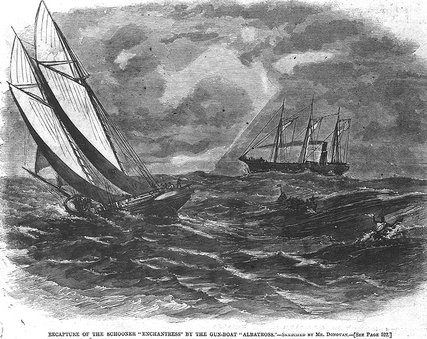
This scene depicts the recapture of the Enchantress, which had been taken by Confederate raiders from the privateer Jefferson Davis, by the USS Albatross.
“The name of the privateer Jefferson Davis has become a word of terror to the Yankees.”
–Charleston Mercury, August 1861
Today marks the sinking of the infamous Confederate privateer Jefferson Davis, which struck the sandbar offshore St. Augustine Inlet on 18 August 1861. LAMP researchers have been searching for this shipwreck for years, and have made significant historical discoveries in the National Archives and elsewhere, though the location of her physical remains are still a mystery. With the help of Pepe Productions we have even produced a documentary on our hunt, “The Search for the Jefferson Davis.” Yesterday’s New York Times carried a tribute to the history of this Rebel raider, a great read for this, the anniversary of her loss off our nation’s oldest port.
Not long after setting sail from Massachusetts, the Cuba-bound merchant schooner Enchantress spied a square-rigged brig approaching, painted black, with dark sails and black mastheads and yards. As the vessel drew near the merchantman, a voice ordered the Enchantress to heave to. Shortly, a boat containing an officer and six men rowed alongside. Upon climbing over the gangway, the officer confronted the merchantman’s captain, demanding immediate surrender of his vessel. Facing the muzzles of the raider’s cannon, and with only a single musket on board, the schooner’s captain had no alternative but to submit. It was piracy, plain and simple — but piracy condoned and supported by the Confederacy.
The Enchantress, captured on July 6, 1861, was the latest prize for the Rebel privateer Jefferson Davis. Known affectionately, even reverentially, by Southerners as the Jeff Davis, the ship’s adventures were followed closely on land. With the Union blockade tightening around Southern ports, the scrappy Jeff Davis seemed to offer hope that the Confederates could still change the balance of the Civil War at sea.
Click here to watch the trailer for LAMP’s premiere documentary, “The Search for the Jefferson Davis!”
The NYT article provides a great overview of the history of this vessel, from its early days as a merchant ship (named Putnam) through its dark history as an illegal slave ship (named Echo), eventually captured by the U.S. Navy. Her human cargo of enslaved Africans were liberated and transported to their new lives in Liberia, and the ship itself was sold at auction in Charleston, on the eve of Civil War.
On April 17, 1861 – just a few days after the fall of Fort Sumter signaled the beginning of hostilities – Confederate President Jefferson Davis issued a proclamation soliciting applications for prospective privateers: commerce raiders owned and crewed by private individuals whose mission it would be to prey upon Northern shipping; essentially, they were to be state-sponsored pirates. Hunter [the ship’s new owner] immediately devised a third incarnation for his vessel, and enlisted several of Charleston’s wealthier citizens as shareholders. In mid-June 1861, they obtained a letter of marque – a printed government authorization – commissioning the Echo, now rechristened the Jefferson Davis, as a Confederate privateer.
On June 28, amid great fanfare, Coxetter [the ship’s captain] weighed anchor in Charleston Harbor, and – armed with five ancient cannons and an “armory well stocked with double-barreled shotguns, muskets, cutlasses, and revolvers” — sailed his black commerce raider through Maffit’s Channel. After easily running the Union blockade, he plotted a course to the waters off New England, in search of Northern merchant vessels.
He soon found them. Over the next seven weeks, in what the Department of the Navy’s Historical Center describes as “the last truly classic cruise in the history of private-armed sea power,” Coxetter captured three schooners, three brigs, two ships and a bark. The Northerners – especially those along the Eastern Seaboard – were apoplectic.
The rebel raider had become the most successful privateer of the entire Civil War. Of the nine ships she captured, however, only two were safely sailed to Confederate ports to be sold at auction, the proceeds divided among the shareholders and crew. One other captured ship was burned by the privateers to prevent its recapture, three others were released unharmed, and three were recaptured, by the blockading Union Navy and in one case by the captured ship’s cook, an African American who knew his freedom was at risk if the ship made it to a Southern port.
The fact that only two prizes out of the nine captured generated any profit is a testament to the new era of modern naval warfare, which made privateering an outmoded and unprofitable wartime endeavor. Most privateer captains took to captaining blockade runners–another patriotic maritime cause for the Confederacy, and one that proved more lucrative for captains and investors. Commerce raiding would continue, but by naval vessels such as the CSS Alabama and CSS Florida, as opposed to private men-of-war. The Jefferson Davis herself suffered an ignominious fate at the close of her glorious first cruise, running aground on the sand bar outside the St. Augustine Inlet. Despite the loss of the vessel, the crew was treated to a hero’s welcome by the townspeople of St. Augustine.
The cruise of the Jeff Davis ended abruptly on Aug. 18. After weathering a storm off St. Augustine, Fla., the privateer entered the harbor to re-provision, and promptly ran aground. Although the crew was unharmed, the vessel was lost. The townspeople enthusiastically rowed the captain and crew to shore, to the accompaniment of the town’s church bells and the applause of its citizens.
The celebrations continued for Captain Louis Coxetter, who was further lauded upon his arrival back in Charleston by cheering crowds, presented with a gold watch, and dubbed by the Charleston Mercury the “Paul Jones of the War of 1861.”
And it happened right here, on this day 150 years ago, at our nation’s oldest port.

